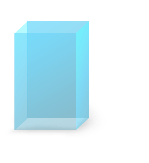The volume
of a solid object or a liquid is a result of the volume of each of the
particles that it is made of and their arrangement in space, that is,
how they fit together.
However, the volume
of a gas is due to the space that separates the particles that it is
made of, which is large compared to the size of the particles (this
size hardly contributes to the total volume).
It is easy to calculate the volumen of a parallelepiped
like the one in the picture on the right. You only have to calculate the product of the
three dimensions: length times width times height. When the object has an irregular
shape, it is possible to measure its volume by immersing it in water and measuring the
volume of the water displaced.
The following visual will allow you to calculate the volumes of parallelepipeds.

